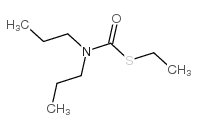Eradicane

Eradicane structure
|
Common Name | Eradicane | ||
|---|---|---|---|---|
| CAS Number | 759-94-4 | Molecular Weight | 189.31800 | |
| Density | 0.95 | Boiling Point | 127°C (20 torr) | |
| Molecular Formula | C9H19NOS | Melting Point | N/A | |
| MSDS | Chinese USA | Flash Point | 116 °C | |
| Symbol |

GHS07 |
Signal Word | Warning | |
|
Reactions of thiocarbamate, triazine and urea herbicides, RDX and benzenes on EPA Contaminant Candidate List with ozone and with hydroxyl radicals.
Water Res. 42(1-2) , 137-44, (2008) Second-order rate constants of the direct ozone reactions [formula: see text] and the indirect OH radical reactions [formula: see text] for nine chemicals on the US EPA's Drinking Water Contaminant Candidate List (CCL) were studied during the ozonation and oz... |
|
|
Influence of metam sodium on the dissipation and residual biological activity of the herbicides EPTC and pebulate in surface soil under black plastic mulch.
J. Agric. Food Chem. 48(10) , 4681-6, (2000) Metam sodium is a potential replacement for methyl bromide, which is used to control soil pests. Metam sodium rapidly breaks down in the soil to form methylisothiocyanate (MITC). Dissipation of the herbicides EPTC and pebulate in a silt loam soil under plasti... |
|
|
Photodegradation of the herbicide EPTC and the safener dichlormid, alone and in combination.
Chemosphere 46(8) , 1183-9, (2002) Photodegradation of the herbicide EPTC (S-ethyl-N, N-dipropylthiocarbamate), and the safener dichlormid (2,2-dichloro-N, N-diallylacetamide) has been examined in methanol and in water solutions. Irradiation of EPTC and dichlormid with UV light at 254 nm cause... |
|
|
Comparative three-dimensional quantitative structure-activity relationship study of safeners and herbicides.
J. Agric. Food Chem. 48(3) , 926-31, (2000) The competitive antagonist hypothesis for safeners and herbicides was investigated by studying the 3D similarity between 28 safener and 20 herbicide molecules in their putative biologically active, low-energy conformations using comparative molecular field an... |
|
|
Health risk above the reference dose for multiple chemicals.
Regul Toxicol Pharmacol 30(2 Pt 2) , S19-26, (1999) Recent work indicates that the regression of toxicity data viewed as categories of pathological staging is useful for exploring the likely health risk at doses above a Reference Dose (RfD), which is an estimate (with uncertainty spanning perhaps an order of m... |
|
|
Metabolic activation of herbicide products by Vicia faba detected in human peripheral lymphocytes using alkaline single cell gel electrophoresis.
Toxicol. In Vitro 21(6) , 1143-54, (2007) Ametryn and metribuzin S-triazines derivatives and EPTC thiocarbamate are herbicides used extensively in Mexican agriculture, for example in crops such as corn, sugar cane, tomato, wheat, and beans. The present study evaluated the DNA damage and cytotoxic eff... |
|
|
Comparison of the persistence of EPTC, metribuzin, and propanil in Saskatchewan field soils.
Bull. Environ. Contam. Toxicol. 29(2) , 243-7, (1982)
|
|
|
Microbial toxicity of pesticide derivatives produced with UV-photodegradation.
Bull. Environ. Contam. Toxicol. 79(3) , 356-9, (2007) Our study aimed at acquiring information about the biological effect of pesticides and their degradates produced by UV-treatment on microbiological activity. Five photosensitive pesticides (carbendazim, acetochlor, simazine, chlorpyrifos, EPTC) and six repres... |
|
|
Skin aging and photoaging alter fatty acids composition, including 11,14,17-eicosatrienoic acid, in the epidermis of human skin.
J. Korean Med. Sci. 25(6) , 980-3, (2010) We investigated the alterations of major fatty acid components in epidermis by natural aging and photoaging processes, and by acute ultraviolet (UV) irradiation in human skin. Interestingly, we found that 11,14,17-eicosatrienoic acid (ETA), which is one of th... |
|
|
Nitrosamines in formulations of deet and EPTC.
Bull. Environ. Contam. Toxicol. 44(1) , 13-8, (1990)
|